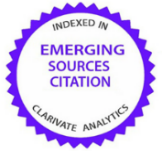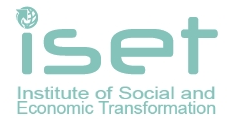Elements of control of competitiveness of telecommunication companies
Abstract
Introduction. The importance of telecommunications in the socio-economic sphere is growing, providing support for the development of the national economy, since the priority development of telecommunications, compared with the overall pace of economic development, significantly increases the competitiveness of the Ukrainian economy. Therefore, the management of telecommunications companies is defined as one of the priority areas of government in the face of growing competition, which makes the problem of increasing the competitiveness of telecommunications services and the telecommunications operator as a whole urgent.
Aim and tasks. The aim of the article is to study the methodological issues of substantiating the elements of enterprise competitiveness in the telecommunications services market, as well as studying the gradation of the level of competitiveness and recommendations for their use in managing the competitiveness of an enterprise.
Results. The scientific and theoretical approaches to the essence of the concept of «competitiveness» are considered. The study made it possible to form its own scientific vision of the economic category “competitiveness of telecommunication companies”. It is noted that modern global trends in the development of the telecommunications market affect its new type in the conditions of the formation of the information society. The main forms of competition in the telecommunications services market are considered. The features of modern telecommunications are highlighted. Disclosed policy in the space of competition regulation in the market of telecommunication services.
Conclusions. Identified and analyzed the basics of managing the competitiveness of telecommunications companies operating in a competitive environment, which is characterized by constant technological innovation.. The main elements of the process of managing the competitiveness of telecommunications companies are substantiated as components of the internal and external environment that determine or can determine the future performance of the company in the international and domestic markets, which will help create the conditions for the implementation of a highly developed information and telecommunications infrastructure to provide telecommunications services to all segments of the population.
Keywords:
competition, elements, competitiveness, services, telecommunication companies, competitiveness managementReferences
2. Vorobienko P. (2009). Definition of indicators of telecommunication service competitiveness. Еconomics: problems of theory and practice, 248, 1101–1109. [in Ukraine]
3. Ivanov, Ye. (2006). Mechanisms of state regulation of the Telecommunication sphere Actual problems of state management. Odessa. [in Ukraine]
4. Dragan, O.I. (2008). Competitiveness of companies in the technology field: methodological aspect. Economics of market relations, 1, 55-59. [in Ukraine]
5. Gruber, H. (2001). Competition and innovation: the diffusion of mobile telecommunications in central and eastern Europe. Information Economics and Policy, 13 (1), 19-34.
6. Koval, V. (2013). Integration processes in the telecommunication sector in Europe. Současná Evropa, 2, 129-141.
7. Laffont, J.J., & Tirole J. (1996). Creating competition through interconnection: Theory and practice. Journal of Regulatory Economics, 10( 3), 227-256. DOI: 10.1007/BF00157671
8. Levy, B., & Spiller P. (1994).The Institutional Foundations of Regulatory Commitment: A Comparative Analysis of Telecommunications Regulation. Journal Of Law Economics & Organization, 10 (2), 201-246.
9. Gruber, H., & Verboven, F. L. (1998). The Diffusion of Mobile Telecommunications Services in the European Union. (CentER Discussion Paper; Vol. 1998-138). Tilburg: Vakgroep CentER.
10. Korablinova I.A. (2011) Management competitiveness of telecommunications operators in modern terms. Thesis. Thesis. on competition sciences degree of Candidate of economic sciences. Odessa National Academy of Telecommunications. Popov, Odessa. [in Ukraine]
11. Petrova, M., Tepavicharova M., & Boykova L. (2017). Improvement of the efficiency and competitiveness through the implementation of benchmarking in the organizations. Bulletin of Ablai Khan KazUIR and WL, 1 (27), 79-86.
12. Olley G. S. & Pakes A. (1996). The Dynamics of Productivity in the Telecommunications Equipment Industry, Econometrica, 64 (6), 1263-1297.
13. GICS (2015). Consultation on potential changes to the global industry classification standard (GICS®) structure in 2015. Retrieved from http://www.msci.com/resources/pdfs
14. Koval, V., Slobodianiuk, O., & Yankovyi, V. (2018). Production forecasting and evaluation of investments using Allen two-factor production function. Baltic Journal of Economic Studies, 4(1), 219-226. doi.org/10.30525/2256-0742/2018-4-1-219-226.
15. Porter, M. (1985). Competitive Advantage: Creating and Sustaining Superior Performance. NY: Free Press.
16. Houpis, G., Rodriguez, J. M., Serdarević, G., & Ovington, T. (2016). The Impact of Network Competition in the Mobile Industry. Competition and Regulation in Network Industries, 17(1), 32–54.https://doi.org/10.1177/178359171601700102
17. Information Society (2017). State Statistics Service of Ukraine. Retrieved from http://ukrstat.org.
18. NCCIR (2017). National commission for the state regulation of communications and informatization. On the results of the analysis of the markets for terminating traffic on fixed and mobile (mobile) communication networks: Decision No. 549 dated 10/24/2017. Retrieved from http://nkrzi.gov.ua.

This work is licensed under a Creative Commons Attribution-NonCommercial 4.0 International License.
If the article is accepted for publication in the journal «Economics. Ecology. Socium» the author must sign an agreementon transfer of copyright. The agreement is sent to the postal (original) or e-mail address (scanned copy) of the journal editions.





















